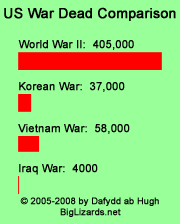August 18, 2006
SF Strap-Ons
The Predator vs. the Eagle... sounds like a new series from Marvel or DC. But really, we're talking about the great divide among Air Force brass over whether it's better to put more emphasis on actual warplanes, such as the F-15 Strike Eagle or the F/A-18 Hornet, or pour more resources into unmanned Predator drones, flown in Iraq, Afghanistan, and other countries, but piloted (according to Robert Kaplan) mostly from trailers at Nellis Air Force Base in Las Vegas (subscription required to read this link, which costs $1 million, I think).
In this case, the "SF" in the title stands not only for Special Forces but also for science fiction, because this story is really about both: science fiction become reality for use by Special Forces in the war against jihadi terrorism.
In the Drone Wars, there are clear advantages to each competitor:
- Human pilots are actually present in the cockpit with the real attack planes, which always gives them an advantage in perception: they know what's going on better than does a pilot flying remotely. They can not only see better, they can hear and feel, or sense, the progress of the engagement.
- But that also means they are in danger themselves, obviously; and less obviously, the ability of the plane is held back by the limitations of the human body. It's easy enough to design a plane that can make a 14-G turn; but it's impossible to locate a pilot who can do the same.
- The drones (unmanned aerial vehicles, or UAVs), besides the obvious advantage that they don't risk an American life, also have the advantage of being much, much smaller than an airplane, which must be big enough to house one or two human beings; thus, the Predators are virtualy invisible on radar and hard to spot even with the naked eye.
- However, they're also slow; they fly by propeller, not jet, and it can take them a long time to get where they're going.
Plus, being so much smaller, they cannot carry as many armaments as a full-sized plane can -- only a couple of Hellfire missiles or JDAM-equipped bombs, in the case of the prevalent MQ-1 Predator.
By contrast, the A-10 Thunderbolt II "Warthog" carries up to eight missiles or bombs, plus the devastating 30mm Avenger Gatling gun, which can fire depleted Uranium shells at a rate of up to 70 rounds per second (after the first, somewhat slower second)... that would be 4,200 rounds per minute, except that it only carries 1,350 rounds. Even so, that is considerably more armament than any UAV carries.
So the argument rages: Man, or machine? But as often happens, the philosophical debate is about to be smashed wide open by a technological advance: a German company, ESG, has developed monofiliment strap-on wings. Holy bat-wings, Batman!

Glidertroopers of tomorrow's war
Airborne units can use these wings in conjunction with a normal parachute to leap out of an airplane and glide for up to 120 miles before pulling the ripcord. In addition, the wings double as storage lockers, allowing the paratrooper to carry 200 lbs of gear to a safe landing.
Elite special forces troops being dropped behind enemy lines on covert missions are to ditch their traditional parachutes in favour of strap-on stealth wings.
The lightweight carbon fibre mono-wings will allow them to jump from high altitudes and then glide 120 miles or more before landing - making them almost impossible to spot, as their aircraft can avoid flying anywhere near the target.
The range means that the actual insertion aircraft need not get anywhere near the target dropzone, dramatically improving the survivability not only of the plane and its crew but the paratroopers themselves. In many cases, such a range -- which can be hugely extended by the addition of a small turbojet engine on the wings -- means that the plane needn't even enter the airspace of the target country; they can drop the paratroopers over friendly territory, allowing them to glide (or fly) themselves into enemy territory.
The radar signature is, of course, barely larger than the paratrooper himself... which means nearly as small as a UAV; but because the wings have human "pilots" (airborne troops), if the tactical situation changes, they can react on the fly (dang!)... I mean, they can just wing it (stop me, someone!)... well, they can respond to their own on-the-spot threat assessment.
One of the critiques that Robert Kaplan levels at the increased reliance of UAVs is that, since they're remotely piloted from the United States, there is too much danger that the top Air Force brass will over-supervise each mission and cause mischief, as in Vietnam; having "glidertroopers" carry out these missions avoids that problem, naturally, since the men making the decisions are the non-coms actually on the ground... or rather, in the troposphere.
It's not too great a jump to imagine a slightly more powerful engine with more fuel, and lightweight, mounted guns or missiles that the glidertroopers can operate. Those would just be minor improvements to what is already demonstrated technology, but the impact on future warfare would be colossal: invisible flying serpents with perfect night vision (NVGs) and a lethal dragon's breath? What would such a unit be called -- the Quetzalcoatl Battalion of the Smaug Regiment?
Swarms of flying monkeys could buzz in from an unexpected quarter, shooting Gatling guns and firing missiles; then disperse in all directions, silent, unseen, untrackable by radar, only to regroup and swarm back from a new angle. An individual man could range high above a city, using telescopic night-vision goggles to follow a small group of terrorists to their lair -- then swoop in and destroy it with a couple of well-placed JDAMs or bursts of gunfire.
There is no reason why slightly more powerful engines could not allow a man to take off from the ground, which would give special forces, even those not trained as glidertroopers, a perfect way to extract from a mission: they return to a pre-determined spot, where wings have previously been hidden (before the enemy is alerted to our presence), strap them on, and fly away to safe rendezvous coordinates; the wings would be equipped with autopilots that use GPS to fly their human cargo in to a perfect landing, all by themselves. This avoids the dangerous necessity of getting a helo into a combat zone now buzzing with enemy activity, following a SEAL or Ranger mission.
And now that I think of it, the same wings, packed with medical equipment, could have a huge impact on military or civilian search and rescue: individual paramedics could zoom across the search area at 150 mph, anywhere from fifteen hundred feet to ten feet off the ground. Once they find victims, if they can't get a helo in to evacuate them (due to proximity to a cliff, for example), they can request an airdrop of some fuel, strap the wounded into the wings, and program them to fly to a location where a rescue helicopter can land.
We could also use these wings to evacuate people trapped inside a burning highrise: skyscrapers could be required by law to keep some large number of such gliders in storage on the roof; a fire-department "smokeglider" flies in, helps victims to strap in, and sends them over the side, where the autopilot takes them a safe distance away and lands.
Unless we actually internalize a science-fiction mentality, we cannot analyze the future.
The one thing we can say with certainty about the future is that it will be very different from the past. It may not differ in just the way we imagine; but without developing the mental muscles of open-minded speculation -- and the sense that technology will do more to determine future society than any other trendline (because technology affects all of the rest!) -- we haven't even a wing or a prayer of being able to respond to that future when it arrives.
Which will be sooner than you think, but later than you wish.
Hatched by Dafydd on this day, August 18, 2006, at the time of 5:13 PM
Trackback Pings
TrackBack URL for this hissing: http://biglizards.net/mt3.36/earendiltrack.cgi/819
Comments
The following hissed in response by: KarmiCommunist
Hezbollah just proved that people must be willing to die during a *WAR*, and use their own family as Cannon Fodder. If America and Israel are unwilling to have deaths during *WAR*, then they have no clue what comes next...so to speak gently.
The above hissed in response by: KarmiCommunist ![[TypeKey Profile Page]](http://biglizards.net/blog/nav-commenters.gif) at August 18, 2006 6:26 PM
at August 18, 2006 6:26 PM
The following hissed in response by: Hal
Hm . . . I don't think these things have dead-launch capabilities. I think they're meant for jumping, like a parachute.
Meaning, your extraction scenario is implausible.
Still, cool tech, and cool potential applications.
The above hissed in response by: Hal ![[TypeKey Profile Page]](http://biglizards.net/blog/nav-commenters.gif) at August 18, 2006 6:45 PM
at August 18, 2006 6:45 PM
The following hissed in response by: Mulletocracy
As much as I dislike communists, I have to agree with the comment above. There is a certain moral element to warfighting that is lost when you are unwilling to put your young men in harm's way for a cause. As unpleasant as it is, a country has to experience loss in wartime or it can't win.
It also reminds me of Captain Manfred Richthofen, one of the best pilots to ever live: "in my opinion, the aggressive spirit is everything." Machines do not have an aggressive spirit. E-4s sitting at a computer thousands of miles from a warzone do not have an aggressive spirit. When you're dropping bombs in a close air support role near friendlies, you need to have an aggressive spirit on par with that of grunts on the ground, and you only do that by being there with them, exposed to the same dangers they are. That is also the same rationale the Marines use for putting their F/A-18 pilots (and all other pilots) through a six-month infantry officer course before going onto to flight school. Aggressive spirit.
The above hissed in response by: Mulletocracy ![[TypeKey Profile Page]](http://biglizards.net/blog/nav-commenters.gif) at August 18, 2006 6:56 PM
at August 18, 2006 6:56 PM
The following hissed in response by: nk
Call me a curmudgeon, but there is actually a very valid reason why "generals are always prepared to fight the last war". They know what worked. I am all in favor of drones -- they are about the same price as a cruise missile but much more surgical although, as Daffyd points out, more vulnerable because they are so slow. Paratroops have always been an idea in search of an application. The Luftwaffe tried to use them in force to take Crete in 1940. Greek farmers used them for target practice as they were floating down and killed them with brushhooks and pitchforks while they were trying to untangle themselves. I believe the 101st Airborne suffered 50% losses in the D-Day invasion and although they had outflanked the Germans they were too lightly armed to be effective. (I will defer to real military historians on this.) Paratroops, in my opinion, should be limited to commando units for clandestine missions behind enemy lines.
Whether made of metal or flesh and blood, the fighter which will win the war is the one which is armed heavily enough and armored well enough to outlive the enemy.
The above hissed in response by: nk ![[TypeKey Profile Page]](http://biglizards.net/blog/nav-commenters.gif) at August 19, 2006 6:41 AM
at August 19, 2006 6:41 AM
The following hissed in response by: Infidel
Hm . . . I don't think these things have dead-launch capabilities. I think they're meant for jumping, like a parachute.
Meaning, your extraction scenario is implausible. "
What are the extraction scenarios for paratroops now? Other than HALO jumps, which are far more vulnerable, there is no better way to stealthily inject combat squads into a remote area.
And BigLiz, they used to call this "thinking outside the box", something the populace in general and the military specifically are rather bereft in accomplishing.
The above hissed in response by: Infidel ![[TypeKey Profile Page]](http://biglizards.net/blog/nav-commenters.gif) at August 20, 2006 1:23 PM
at August 20, 2006 1:23 PM
Post a comment
Thanks for hissing in, . Now you can slither in with a comment, o wise. (sign out)
(If you haven't hissed a comment here before, you may need to be approved by the site owner before your comment will appear. Until then, it won't appear on the entry. Hang loose; don't shed your skin!)© 2005-2009 by Dafydd ab Hugh - All Rights Reserved













